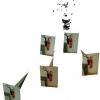Free Online Productivity Tools
i2Speak
i2Symbol
i2OCR
iTex2Img
iWeb2Print
iWeb2Shot
i2Type
iPdf2Split
iPdf2Merge
i2Bopomofo
i2Arabic
i2Style
i2Image
i2PDF
iLatex2Rtf
Sci2ools
CVPR
2008
IEEE
2008
IEEE
What can missing correspondences tell us about 3D structure and motion?
Practically all existing approaches to structure and motion computation use only positive image correspondences to verify the camera pose hypotheses. Incorrect epipolar geometries are solely detected by identifying outliers among the found correspondences. Ambigous patterns in the images are often incorrectly handled by these standard methods. In this work we propose two approaches to overcome such problems. First, we apply non-monotone reasoning on view triplets using a Bayesian formulation. In contrast to two-view epipolar geometry, image triplets allow the prediction of features in the third image. Absence of these features (i.e. missing correspondences) enables additional inference about the view triplet. Furthermore, we integrate these view triplet handling into an incremental procedure for structure and motion computation. Thus, our approach is able to refine the maintained 3D structure when additional image data is provided.
Additional Image Data | Computer Vision | CVPR 2008 | Image Triplets | Motion Computation | Positive Image Correspondences | View Triplet |
| Added | 12 Oct 2009 |
| Updated | 28 Oct 2009 |
| Type | Conference |
| Year | 2008 |
| Where | CVPR |
| Authors | Christopher Zach, Arnold Irschara, Horst Bischof |
Comments (0)

